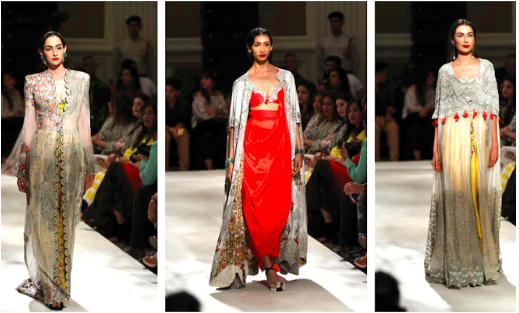Discover the Best Selection of Authentic Eastern Wear
As you check out the myriad styles and layouts, each piece holds a tale waiting to be unwinded, inviting you to embrace the virtuosity and elegance that Eastern style envelops. Prepare to be captivated by the attraction of Eastern wear and submerse on your own in a world where every garment is a testimony to centuries-old customs and beautiful craftsmanship.
History of Eastern Style

Eastern style has actually likewise been shaped by numerous conquests, trade courses, and colonial influences over the centuries. The mixing of various cultures has caused unique apparel styles that are abundant in history and importance. Today, Eastern style proceeds to mesmerize the global market, with designers attracting ideas from typical attire to produce modern-day analyses that interest a vast target market. The abundant tapestry of Eastern style background offers as a testament to the imagination and craftsmanship of the craftsmens that have actually added to its advancement.
Types of Eastern Outfit
Checking out the varied array of typical garments discovered in Eastern cultures unveils an interesting tapestry of designs and designs that reflect one-of-a-kind histories and social identities (eastern wear pakistan). From the intricate embroidery of Indian sarees to the moving shapes of Japanese kimonos, Eastern clothing includes a large range of designs. In South Asia, the sophisticated and vivid salwar kameez is a preferred option for females, while men commonly choose the classic kurta pajama. Relocating in the direction of the Center East, the flowing abayas and complex kaftans are associated with standard Arabian style. In East Asia, the smooth lines of Chinese cheongsams and the vibrant colors of Oriental hanboks showcase the rich sartorial heritage of these areas. Furthermore, Southeast Asia flaunts the detailed batik prints of Indonesia and the sarongs of Malaysia. Whether it's the luxurious materials of Persian clothing or the minimalist style of Vietnamese ao dai, Eastern attire provides a fascinating look into the varied societies and customs of the East.
Workmanship and Materials
An extensive evaluation of Eastern outfit reveals the careful workmanship and charming products that underpin these typical garments. Eastern wear is renowned for its detailed embroidery, delicate handwork, and interest to detail that display the ability and creativity of the craftsmen. From the dynamic sarees of India to the moving bathrobes of the Center East, each garment is a work of art of accuracy and commitment.
Craftsmanship in Eastern attire typically involves time-honored strategies gave through generations. Craftsmens spend hours, in some cases he has a good point days, carefully developing complex patterns and designs that embellish the fabric. Whether it's the zardozi job on a Pakistani shalwar kameez or the kantha sewing on a Bangladeshi saree, the degree of craftsmanship is unmatched.
In addition, the materials made use of in Eastern wear are meticulously picked to guarantee both high quality and authenticity. eastern wear pakistan. Fabrics like silk, chiffon, velour, and cotton are frequently made use of, each chosen for its unique properties that enhance the final garment. Decorations such as grains, sequins, and mirrors include a touch of glamour and high-end to these traditional sets, making them really stand out on the planet of style
Popular Eastern Put On Trends
Recent years have witnessed a rebirth in the popularity of traditional Eastern wear, with a notable focus on combination styles and contemporary adaptations. One famous trend in Eastern wear is the incorporation of modern-day components into standard attires, creating an unique blend of social heritage and contemporary fashion. Designers are reimagining timeless silhouettes, such as the saree and salwar kameez, by infusing them with western cuts, innovative draping techniques, and non-traditional embellishments.

Furthermore, minimal aesthetic appeals and monochromatic shade palettes have gained traction in Eastern wear, supplying a sophisticated and imp source downplayed appearance. This change towards simplicity shows a contemporary take on traditional styles, interesting those seeking a much more refined and elegant fashion declaration.
Tips for Styling Eastern Clothes
Including contemporary components and conventional workmanship into Eastern put on opens up a myriad of styling opportunities for style lovers looking to develop unique and culturally abundant clothing. When styling Eastern attires, it's necessary to find a balance between typical components and contemporary trends. One suggestion is to mix and match various items, such as pairing a traditional embroidered kurta with modern pants for a blend look. Additionally, don't shy away from try out vivid colors and intricate patterns that are characteristic of Eastern outfit.
Accessories play a vital role in elevating an Eastern attire. Pay attention to footwear choices, deciding for standard mojaris or juttis for a total Eastern-inspired outfit.
Finally, confidence is crucial when styling Eastern put on. Accept the cultural heritage and workmanship behind each item, and use it with satisfaction to truly symbolize the essence of Eastern fashion.
Final Thought
To conclude, Eastern style uses an unique mix of tradition and modernity, showcasing the rich read review social heritage and workmanship of the East. With a diverse array of designs and products, Eastern attire astounds fashion fanatics worldwide. By exploring the background, types, craftsmanship, and fads of Eastern wear, individuals can accept the elegance and narration facets of this social attire in their wardrobe.
The history of Eastern fashion traces back centuries, showing diverse social influences and conventional workmanship. Today, Eastern style continues to mesmerize the worldwide market, with designers drawing ideas from standard outfit to create contemporary interpretations that appeal to a large target market. One famous trend in Eastern wear is the incorporation of contemporary elements into traditional clothing, creating an one-of-a-kind mix of social heritage and modern fashion.Integrating modern components and conventional craftsmanship into Eastern use opens up a myriad of styling opportunities for style lovers looking to create culturally rich and special clothing. eastern wear pakistan.In conclusion, Eastern fashion provides an one-of-a-kind blend of tradition and modernity, showcasing the rich social heritage and craftsmanship of the East